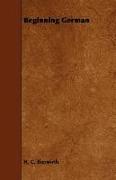- Start
- Beginning German
Beginning German
Angebote / Angebote:
PREFACE TO THE SECOND EDITION IN all essential features - the method, the manner of presentation or statement, and the topics, as well as the order, of the lessons -Beginning G e m remains unchanged. The increase in the numbcr of pages over the first edition is accounted for by the aIternative exercises in each lesson, the four optional chaptcrs headed Review and Drill, and a series of special, likewise optional, exercises at the end of the lessons. In several matters of detail, however, I have endeavored to profit from criticisms and from such suggestions as I could embody in the book without changing its general character. To all friends and colleagues who have thus helped me, I here express my thanks. The German exercises of the lessons are Iettered A and B the English, C and D of which either A or B may be used in combination with either C or D. The teacher, however, will find A and C the best combination for one year in another year, or for purposes of review, he can use B and D. If some of the exercises should seem rather long they were made longer than those of the first edition at thc request of a number of teachers, a few sentences in each may easily be omitted. But I deprecate as much in this edition as in the first the translation of the English exercises mithout sufficient previous study of the German and the explanatory notes. The Abstract of Grammar, in which scarcely anything has been changed, will be published separately, as heretofore and so will the pamphIet of New Excrcises, which, although no longer strictly new, may still serve as a supplementary set. THIS book consists of a series of thirty lessons and an abstract of grammar. On the lessons and the best way of using them, I have only a few suggestions to make, and these I will venture to put in a somewhat categorical form. First, have your students recite as much as possible with their books closed. Secondly, dictate a few sentences or phrases to them at every lesson. Thirdly, postpone sentence writing and so-called composition until the ear is fairly well trained and the new language has become aliw in the students mind. And fourthly, before your scholars do an English exercise, Iet them carefully reread the preceding German sentences that should serve them as models. I may add that these suggestions are neither original nor novel, and I dare say that if they had been followed more closely since the Committee of Twelve lent them the weight of their authority, fewer candidates for admission to coIlege would be found deficient in the translation into German, and most would do better in the translation of German into English. The fact is that, notwithstanding all our conceits to the contrary, we are still too much under the sway of the traditional methods of teaching the dead languages. In the second part of the book, the abstract of grammar, I have so far departed from the customary way of presenting the subject of accidence that I must needs give my reason for doing so. It is this if the initial difficulty for most English- speaking students of German lies in mastering the inflections, rather than in grasping the uses of the parts of speech, or what me call syntax, , it ought to be more practical to group different parts of speech under the same type of inflection than to group different types of inflection under the same part, of speech. The former is the method that I have followed. The latter is again a traditional method, that of logicians but it is not necessarily the best, nor even the most rational method, even if it be the most logical...
Folgt in ca. 15 Arbeitstagen


